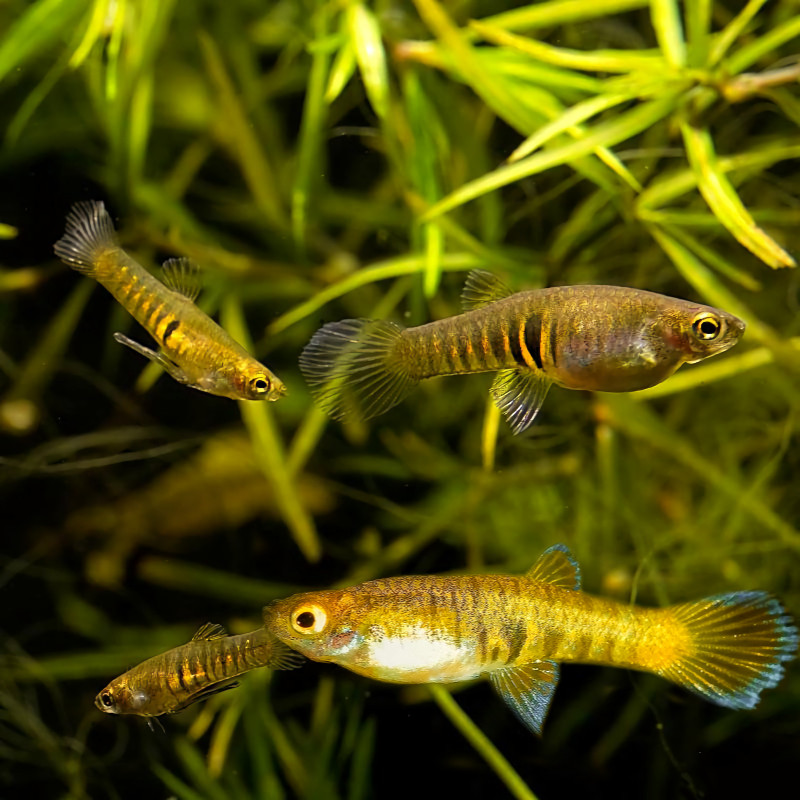More info
A very beautiful but somewhat shy species that seems to be quite rare in the wild as well as in aquarism , occasionally available, is for the true collector.
The genus Neoheterandria was included in the nominal tribe Heterandriini within the Poeciliidae family as first proposed by Hubbs (1924). Included genera have changed several times, but most commonly comprise Priapichthys, Neoheterandria, Heterandria, Poeciliopsis, and Phallichthys.
Modern phylogenetic studies do not tend to support the monophyly of this assemblage, however, with more recent ones suggesting that Neoheterandria is more closely related to the genera Scolichthys and Xenophallus (Morales-Cazan & Albert, 2012) or to form a distinct geographic subgroup. -clade with Poeciliopsis (Hrbek et al., 2007).
Etymology
Neoheterandria : from Ancient Greek νεο- (neo-), meaning 'new, young', ἕτερος (heteros), meaning 'other, other, different', and ἀνδρός (andros), meaning 'male'.
elegans : from the Latin elegans , meaning 'fine, elegant, beautiful'.
Distribution
Endemic to the Río Atrato drainage in the departments of Choco and Antioquia, northwest Colombia, where the full extent of its extension is unclear.
The type locality is 'Río Truandó, tributary of the Lower Río Atrato, Colombia', and may be restricted to this system.
Maintenance
A pair can be kept in an aquarium with base dimensions of 30 ∗ 20 cm , but larger rooms are needed for a group.
A softly filtered, heavily planted setting is recommended, and exceptionally clean water is a prerequisite, meaning weekly water changes of around 50% are required.
Food
Undemanding and omnivorous, it accepts most foods offered. Being a micropredator, it is particularly fond of small live or frozen varieties such as Artemia or Daphnia , although crushed dry foods are also acceptable.
If the aquarium contains many fine-leaved plants, enough microorganisms should be available for the young.
Behavior
Unsuitable for the general community aquarium due to its small size. It is shyer than the somewhat similar Heterandria formosa and is best kept alone in a small colony.
Females are sometimes aggressive and this can cause casualties, but this behavior can be reduced by maintaining a heavily planted configuration as mentioned above.
Dimorphism and reproduction
Males are significantly smaller than females and have a prominent gonopodium.
As for being able to reproduce them in captivity, the main problem is that the fry are only 2-3 mm long and cannot eat microworms, newborn Artemia and the like in the first few days. Initially they require infusoria -type foods, but they grow quickly and are able to reproduce at an age of only 3 months.
The gestation period is about 30 days. This species has a slightly different method of producing fingerlings than most other viviparous fish, involving a process known as 'superfetation'. This is defined as 'the formation or development of a second fetus when it is already present in the uterus'. Fingerlings at different stages of development can therefore be present in the fish's uterus at any time. In addition, the species' egg yolks are nutritionally poor, and developing fingerlings obtain much of their nutrition from organs that function similarly to the mammalian placenta. As a result of this process, the fry are discarded continuously and not in defined litters. You will see a few fry appearing every day or two for about a week. If well fed, adults will usually not harm them.
Ficha Técnica
- Nome da Espécie: Neoheterandria elegans
- Ordem: Cyprinodontiformes//Poeciliidae
- Autor: HENN, 1916
- Intervalo de pH: 7-8
- Intervalo de Temperatura: 24-28
- Dureza: 5-25
- Tamanho adulto: 2-2.5(cm)
- Aquário recomendado: 30L
- Temperamento: Pácifico
- Origem: Rio Atrato // Colombia
Reviews
No customer reviews for the moment.



